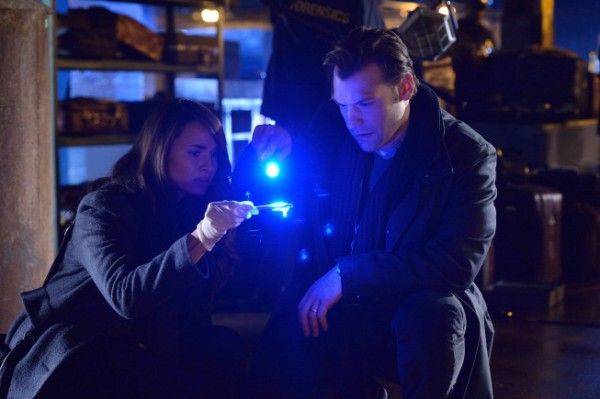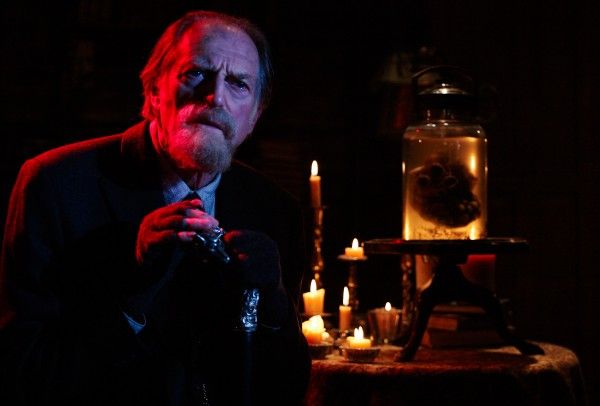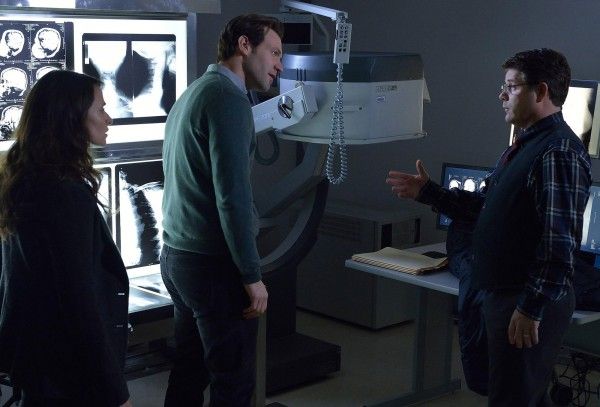Horror mastermind Guillermo del Toro has been fascinated with vampires since he was a teenager and figured out early on the version that he liked more was not the romantic leading man, but the soul-less body, driven to brutality by an unquenchable thirst. In The Strain, his first foray into television, del Toro has created frightening vampire creatures that are worlds apart from the brooding, forlorn vampires that are popular today.
Based on the book trilogy that del Toro co-wrote with Chuck Hogan, The Strain follows a group of CDC scientists who discover a virus has been unleashed on New York City with devastating consequences. Hogan, del Toro and executive producer Carlton Cuse stopped by Comic-Con to screen the season’s third episode for attendees before it aired, but before heading over to Hall H they talked to the press about the show. Hit the jump to read highlights from their interviews.
Question: Guillermo, vampires have gotten so soft in recent years. How much pride do you take in restoring their ruthlessness to the screen?
GUILLERMO DEL TORO: I’ve been dreaming of this vampire since I was a teenager. I collect a lot of vampiric lore. I realized the vampire that interested me was not the vampire that was romantic, but the hollow corpse that was inhabited by an unholy will. I don’t want to prove anyone wrong. When the vampire was birthed by John W. Polidori, he was birthed as a romantic hero and a monster, at the same time. Either obsession is correct, but no one is doing the brutal vampire, so I wanted to do it because it’s what fascinates me.
Chuck, what kind of monster characters inspired you?
CHUCK HOGAN: I was a huge horror fan, especially in my teenage years. Back then, there were a lot of Italian horror movies – some zombie, some just really strange movies that made no sense. I was really into shock and gore. It was really fun to incorporate that and, at the same time, do more mythological stuff, and really tell a whole bunch of different stories and not just go for the splatter.
Carlton, what was it about The Strain that made you want to be a part of it?
CARLTON CUSE: The reason why I agreed to take the project on was that this story is an up-ending of the vampire genre. We had gotten into this place where vampires were getting increasingly handsome, romantic, brooding and existential. They had love life problems. That was their biggest issue. And I thought there was a really great opportunity to go back to the roots of what vampires are, which are really scary, dangerous, parasitic creatures. That excited me. Secondly, I was excited about the idea that I could do it with Guillermo, who I could count on to make the creatures visually imaginative. I don’t think there is anybody better at doing that than him. The most disappointing thing in a creature movie is when the creature feels familiar or uninteresting. I just believed in Guillermo that he would be able to execute the creatures and make them super cool. I think he has delivered an incredibly imaginative array of creatures in this show.
Chuck, what was the writing process like on the novels with Guillermo?
HOGAN: We met and had a long breakfast, and he already had a 12-page outline, which I loved. He had much more there, and I was really excited about it. I suggested a few things, but nothing big. Over the next year, we spent some time going back and forth, and refining it and figuring out if it was going to work. And then, we took it to the publishers and they were very excited that we finished it. This was my first collaboration with anybody. I had never worked with anybody else, and it was just great. It was fantastic, and it continues to be fantastic.
Guillermo, what are the challenges of bringing your idea to television?
DEL TORO: Every special effect goes through me, and every single make-up effect goes through me. I do a final color correction on the cinematography of all the episodes, myself. It’s because I wanted to give them uniformity in the look. The way I tried to design the look was super saturated colors that almost felt like a comic book. I color-coded the show, so there are two colors, cyan and gold. I said, “No red,” except if it’s in the real world, like a fire extinguisher, so that we can reserve the red for the blood. Even if you don’t notice it, the show has a style and that’s the first thing. The second thing I tried to do was give it a cinematic look and give it scope. We did it for the budget and we did it for the schedule, but we wanted to make it ambitious. The challenges were to try and do spectacle and big visual effects within the budget and the schedule.




